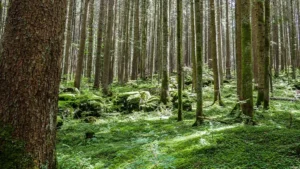What is Sustainable Forestry? Practices & Benefits
- September 17, 2024
- 0 comment
Sustainable forestry is a vital concept that addresses the balance between the need for forest resources and the preservation of forest ecosystems. In an age where deforestation and habitat destruction are critical environmental concerns, sustainable forestry offers a solution that meets the demands of human consumption while ensuring the long-term health of forests.

This practice is not merely about conserving forests but managing them in a way that supports biodiversity, reduces carbon footprints, and nurtures the livelihoods of communities dependent on them. In this article, we’ll explore what sustainable forestry entails, the core practices that drive it, and the broad range of benefits it offers to both the environment and society.
Definition of Sustainable Forestry
Sustainable forestry is the management of forests according to principles that allow for the extraction of timber and other forest products in a way that ensures the health and diversity of the ecosystem are maintained over time. The objective is to meet the current generation’s needs without compromising the ability of future generations to meet theirs.
| Category | Metric | Impact |
|---|---|---|
| Selective Logging | 20-50% reduction in environmental impact | Minimizes forest ecosystem disruption |
| Reforestation | 12 million hectares replanted annually | Restores forest cover and biodiversity |
| Carbon Sequestration | 2.6 billion tons of CO₂ absorbed by forests yearly | Mitigates climate change |
| Economic Contribution | $1.3 trillion in forest products trade | Supports global economy and jobs |
| Biodiversity Conservation | 80% of Earth’s terrestrial species rely on forests | Preserves habitats and species |
| Certification Programs | Over 500 million hectares certified sustainably | Ensures responsible forest management |
This concept is rooted in the understanding that forests play a crucial role in maintaining ecological balance, providing habitat for wildlife, and serving as carbon sinks that help mitigate climate change. By implementing sustainable forestry, we can continue to benefit from the resources forests offer without depleting them.
The Importance of Forest Ecosystems
Forests cover about 31% of the Earth’s land area and are home to over 80% of terrestrial species. They also serve as vital carbon sinks, absorbing carbon dioxide and releasing oxygen, which helps regulate the planet’s climate. Beyond their ecological value, forests also contribute to human well-being by providing food, medicine, and raw materials like timber and paper, supporting countless industries worldwide.
| Category | Metric | Impact |
|---|---|---|
| Carbon Sequestration | 2.6 billion tons of CO₂ absorbed annually by forests | Helps mitigate climate change |
| Biodiversity | 80% of terrestrial species depend on forests | Preserves global biodiversity |
| Global Forest Cover | 31% of Earth’s land area covered by forests | Supports ecosystems and habitats |
| Water Filtration | 75% of freshwater sourced from forested areas | Provides clean water to communities |
| Economic Value | $1.3 trillion in forest products trade annually | Supports global industries and jobs |
| Livelihood Support | 1.6 billion people rely on forests for subsistence | Ensures social and economic welfare |
However, human activities like logging, agriculture, and urban development threaten forest ecosystems. Deforestation and unsustainable forestry practices lead to loss of biodiversity, soil erosion, and increased carbon emissions. This underlines the need for sustainable forest management as a proactive measure to protect forests while meeting human needs.
Core Principles of Sustainable Forestry
Several core principles define sustainable forestry:
- Ecological Responsibility: Sustainable forestry ensures that the forest ecosystem remains intact. This includes conserving biodiversity, maintaining water quality, and preserving soil integrity.
- Economic Viability: Sustainable forestry seeks to provide economic benefits through the harvesting of forest products, without damaging the long-term productivity of the forest.
- Social Responsibility: It acknowledges the rights and needs of indigenous people and local communities who rely on forests for their livelihoods. Sustainable forestry involves these stakeholders in decision-making processes and promotes fair labor practices.
- Long-Term Management: Forestry practices must be planned with long-term goals in mind. This includes ensuring that forests can regenerate and continue to provide resources for future generations.
Sustainable Forestry Practices
To implement sustainable forestry, specific practices must be followed. These methods help maintain the ecological integrity of forests while allowing for the responsible use of resources:

- Selective Logging: One of the most effective sustainable forestry practices is selective logging. Instead of clear-cutting, where entire sections of forest are felled, selective logging focuses on harvesting specific trees while leaving the surrounding forest largely intact. This reduces the environmental impact and allows for the regeneration of the forest.
- Reforestation and Afforestation: Reforestation involves replanting trees in areas where forests have been depleted, while afforestation refers to planting trees in areas that were previously non-forested. Both practices are essential for maintaining forest cover and restoring habitats that have been lost to deforestation.
- Reduced Impact Logging (RIL): RIL is a set of logging techniques designed to minimize the damage to the forest ecosystem. This includes planning the harvest to avoid harming young trees, preventing soil erosion, and protecting wildlife habitats. It requires careful planning and training of loggers to execute the extraction process with minimal disturbance.
- Certification Systems: Certification systems like the Forest Stewardship Council (FSC) ensure that forests are managed sustainably. These certifications provide guidelines and standards for sustainable forestry and ensure that products harvested from these forests are labeled as sustainable. This encourages consumers to make environmentally conscious purchasing decisions, creating a market incentive for sustainable practices.
- Integrated Pest Management (IPM): To protect forests from diseases and pests without relying on harmful chemicals, sustainable forestry often incorporates IPM strategies. This involves using natural predators or resistant tree species to control pests and diseases, reducing the need for pesticides that can harm the environment.
- Community-Based Forest Management: Involving local communities in forest management is a crucial practice in sustainable forestry. Indigenous people and local populations often have a deep understanding of their environment and can offer valuable insights into sustainable practices. Moreover, community-based management ensures that the benefits of the forest are equitably shared, providing local economic benefits while preserving the ecosystem.
The Benefits of Sustainable Forestry
Sustainable forestry provides a broad range of benefits, extending beyond the immediate environmental gains. These advantages affect global efforts to combat climate change, preserve biodiversity, and support economic development.
| Category | Metric | Impact |
|---|---|---|
| Carbon Sequestration | Up to 2.6 billion tons of CO₂ absorbed annually | Reduces global carbon emissions |
| Biodiversity Protection | 80% of forest species protected with sustainable management | Preserves species diversity |
| Economic Output | $1.3 trillion in sustainable forest products trade annually | Boosts long-term industry profits |
| Job Creation | 33 million jobs worldwide supported by forestry | Provides sustainable livelihoods |
| Reforestation Impact | 12 million hectares of forest restored annually | Rebuilds degraded ecosystems |
| Certified Products Market | 80+ countries with certified sustainable forests | Expands eco-friendly market access |
- Environmental Benefits: Sustainable forestry helps maintain biodiversity by protecting the habitats of various plant and animal species. By preventing deforestation and promoting reforestation, sustainable forestry enhances carbon sequestration, thus contributing to climate change mitigation. It also improves water quality by reducing soil erosion and preserving watersheds.
- Economic Benefits: Sustainably managed forests can provide a steady stream of resources for industries such as timber, paper, and pharmaceuticals, ensuring long-term profitability without depleting forest ecosystems. The certification of forest products also opens up access to markets that demand sustainably sourced materials, providing a competitive advantage for businesses that engage in sustainable practices.
- Social Benefits: Sustainable forestry promotes the well-being of communities that depend on forests. By involving local populations in the decision-making process, it ensures that these communities have a say in how their resources are managed. This practice also helps protect the cultural heritage of indigenous peoples, whose way of life is often closely linked to the forest.
- Climate Change Mitigation: One of the most significant benefits of sustainable forestry is its role in combating climate change. Forests act as carbon sinks, absorbing carbon dioxide from the atmosphere. By preventing deforestation and promoting afforestation, sustainable forestry increases the amount of carbon stored in forests, helping to offset greenhouse gas emissions from other sources.
- Biodiversity Conservation: Forests are home to a vast array of species, many of which are not found anywhere else on Earth. Sustainable forestry protects these species by maintaining the integrity of their habitats. This not only preserves biodiversity but also supports ecosystem services that are essential to human survival, such as pollination and water filtration.
Challenges to Sustainable Forestry
While the benefits of sustainable forestry are clear, there are challenges to its implementation. These include economic pressures that prioritize short-term profits over long-term sustainability, lack of awareness or education about sustainable practices, and insufficient enforcement of forestry regulations. Additionally, illegal logging remains a major issue in many parts of the world, undermining efforts to manage forests responsibly.
Another challenge is balancing the needs of industry with environmental concerns. In some regions, industries may resist adopting sustainable practices due to the perceived costs or complexity of certification processes. However, with increasing awareness of climate change and the importance of sustainability, these barriers are gradually being overcome through market incentives, regulatory frameworks, and consumer demand for sustainable products.
The Role of Consumers in Supporting Sustainable Forestry
Consumers play a critical role in promoting sustainable forestry. By choosing products that are certified as sustainably sourced, such as those carrying the FSC label, consumers can support companies that engage in responsible forestry practices. This creates a market demand for sustainably produced goods, encouraging more businesses to adopt these practices.
- Choose Certified Products: Buy products with certifications like the Forest Stewardship Council (FSC) to ensure they come from sustainably managed forests.
- Support Eco-Friendly Brands: Favor companies that prioritize sustainable forestry and responsible sourcing.
- Reduce Paper and Wood Waste: Use recycled or alternative materials and minimize waste from forest-based products.
- Promote Awareness: Share information about sustainable forestry to encourage others to make eco-conscious choices.
- Advocate for Policy Change: Support legislation that promotes sustainable forest management and conservation efforts.
Educating consumers about the importance of sustainable forestry and how their purchasing decisions can impact forest ecosystems is crucial. When consumers understand that their choices can contribute to environmental conservation, they are more likely to support brands that prioritize sustainability.
Final Conclusion
Sustainable forestry represents a balanced approach to forest management, ensuring that we can continue to benefit from forest resources while protecting the health of ecosystems for future generations. Through practices like selective logging, reforestation, and certification systems, sustainable forestry offers a way to meet human needs without depleting the planet’s natural capital. The environmental, economic, and social benefits are immense, from preserving biodiversity to mitigating climate change and supporting local communities.
However, challenges remain, and achieving widespread adoption of sustainable forestry requires collaboration between governments, businesses, and consumers. By making informed choices and supporting sustainable practices, we can all play a part in protecting the world’s forests and ensuring their survival for generations to come.
Frequently Asked Questions (FAQs)
- What is sustainable forestry?
Sustainable forestry refers to the practice of managing forests in a way that meets the current needs for forest products like timber without compromising the health of the ecosystem or depleting resources for future generations. It focuses on maintaining ecological balance, supporting biodiversity, and allowing forests to regenerate. - Why is sustainable forestry important?
Sustainable forestry is essential because it helps prevent deforestation, protects biodiversity, preserves ecosystems, mitigates climate change, and supports communities that rely on forest resources. It ensures that forests can continue to provide economic, environmental, and social benefits for generations to come. - What are the key principles of sustainable forestry?
The core principles of sustainable forestry include ecological responsibility (protecting ecosystems and biodiversity), economic viability (allowing for long-term profitability), social responsibility (supporting local and indigenous communities), and long-term management (ensuring forest regeneration and ongoing productivity). - What are some common sustainable forestry practices?
Some sustainable forestry practices include selective logging (only harvesting certain trees), reforestation and afforestation (planting trees to replace those cut down), reduced impact logging (minimizing environmental damage), and community-based forest management (involving local communities in decision-making). - How does selective logging differ from clear-cutting?
Selective logging involves harvesting specific trees while leaving the surrounding forest largely intact, minimizing environmental damage and supporting regeneration. Clear-cutting, on the other hand, removes all trees in a particular area, which can lead to habitat destruction, soil erosion, and loss of biodiversity. - What role do certification systems like the Forest Stewardship Council (FSC) play in sustainable forestry?
Certification systems like the FSC establish standards for responsible forest management. They ensure that forests are sustainably managed and that products like wood and paper are sourced from these forests. Certified products carry labels that help consumers identify sustainable options, promoting environmentally friendly purchasing decisions. - How does sustainable forestry help combat climate change?
Sustainable forestry helps combat climate change by promoting practices that protect forests, which act as carbon sinks. Forests absorb carbon dioxide from the atmosphere, reducing greenhouse gas levels. Preventing deforestation and promoting reforestation further enhances carbon sequestration, helping to mitigate climate change. - What are the economic benefits of sustainable forestry?
Sustainable forestry ensures the long-term availability of forest products like timber, which supports industries and creates jobs. Certified sustainable products can access eco-friendly markets, offering competitive advantages. Additionally, sustainable forestry practices reduce the risk of depletion, allowing for ongoing profitability. - How does sustainable forestry support local communities?
Sustainable forestry involves local and indigenous communities in forest management decisions, ensuring that they have a voice in how resources are used. It supports local economies by providing jobs and maintaining resources that these communities rely on, such as food, medicine, and raw materials. - What are the challenges of implementing sustainable forestry?
Challenges include economic pressures that prioritize short-term profits, illegal logging, lack of awareness or education about sustainable practices, and insufficient enforcement of forestry regulations. Balancing industrial needs with environmental concerns can also be difficult, but increasing consumer demand for sustainable products is helping overcome these obstacles.
We hope this guide has helped you better understand the key practices and benefits of sustainable forestry. Have ideas or experiences with forest management? Share them below to inspire others and support forest conservation. Don’t forget to pass this guide along to those who care about protecting our forests and fostering a sustainable future.

James Wilson
Forestry AuthorJames Wilson has over 15 years of experience in forestry economics, specializing in sustainable practices, investment opportunities, and financial management. He has contributed to notable publications like "Forestry Today" and "EcoFinance Journal" and is known for providing practical and insightful advice. With a degree in Environmental Economics, James stays updated through continuous learning and active participation in industry discussions. Outside work, he enjoys hiking and nature photography, bringing a well-rounded perspective to his professional role.












Leave your comment